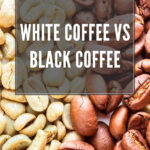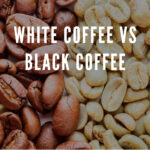Sometimes it feels like new coffee crazes pop up every week at our favorite coffee house. However, it’s hard to determine if a trend is here to stay or should be flushed down the drain with the coffee grounds. White coffee has recently arrived on most menus, and you might be wondering, how is it so different from black coffee?
Before we dive into the differences, the important thing to know is that white and black coffee are made from the same green beans. So how delicious (or disappointing) your morning cup tastes comes down to where you buy your beans.
Let’s take a closer look at this new caffeine craze.
What is White Coffee?
A new-to-many phrase that has made its way into the coffee world is “white coffee,” and you may be wondering what it means. White coffee doesn’t refer to a cup of coffee with milk or blonde color coffee. Instead, it’s referring to the special light roast of the white coffee beans.
The Origins
Even though it feels like this “other” coffee sprang up in the past few years, white coffee has been around for a long time and only just made its way to your favorite coffee shop menu. This light roast coffee originated from Yemen centuries ago!
Recipes have been passed down through generations. In Yemen, they include herbs, spices, and aromatics, called Hawaij. This unique blend of Hawaij gives this coffee its nutty flavor.
The Benefits
White beans are chock full of health benefits. Unlike regular coffee beans, white bean juice retains more caffeine through the roasting process, which means you’ll get that extra jolt to wake you up in the morning.
White beans also have a less acidic taste and less acidic flavor, and they’re gentler on your stomach. And best of all, white coffee options are chock full of plenty of antioxidants. Antioxidants help prevent or delay cell damage and protect your body against diseases.
Overall, this unique light roast retains more essential nutrients that keep your body working strong due to the low temperatures and shorter roasting time.
What is Black Coffee?
Found in almost every household in America, strong coffee rarely needs an introduction. Brewed from ground coffee and consumed by coffee experts and amateurs alike, this dark-colored coffee brew is so much more than meets the eye.
The Origins
If you’re a coffee enthusiast, you’ll love learning the background of black beans. We’ve been drinking brew from them for centuries! According to legends originating from the forests on the Ethiopian plateau, a simple goat herder discovered green coffee beans.
Our favorite coffee beverage made its way to the Arabian Peninsula before expanding to Persia, Egypt, Syria, and Turkey in the 16th century. By the 17th century, the taste of coffee dominated Europe and conquered the United States by the mid-1600s.
The Benefits
Besides being every coffee aficionado’s favorite morning brew, black coffee without milk has a good deal of health benefits. Studies have shown that coffee improves cardiovascular health and lowers cancer risks, diabetes, Parkinson’s disease, and Alzheimer’s.
Black coffee cuts through the brain fog, improving mood, attention, and motivation. Black beans also contain beneficial nutrients that keep your body in tip-top shape.
Of course, there are endless varieties of coffee beans, like arabica or robusta beans. Also, how long the beans are roasted makes a difference. For example, blonde coffee is made by roasting green beans for less time.
The Showdown: White Coffee versus Black Coffee
| White Coffee | Black Coffee | |
|---|---|---|
| Roasting Temperature | 325°F | 450-480 degrees |
| Roasting Time | 5-6 min | 10-16 mins |
| Flavor Profile | nutty, floral, hay-like | bold, hints of chocolate, slightly bitter |
| Caffeine Content | about 100 mg | about 95 mg |
| Acidity | Less acidic | more acidic |
Roasting Temperature and Time
One significant difference between the beans is the method of roasting. The difference in roasting time and the process allows for entirely different flavor profiles. Both processes start with quality green coffee beans and become either lighter roast or darker roast coffee
Standard batches of black coffee use an average roasting temperature of about 450°F to 480°F. This temperature, combined with a roasting time of about 10 to 16 minutes, allows the beans to release more aroma and change from green to brown. In addition, the extended roasting time brings out all the bold flavors and hints of chocolate that we love in our black coffee.
On the other hand, white coffee uses a light roasting process and shorter roasting time. Temperatures should never reach more than 325°F, and the beans only roast for about 5 or 6 minutes. Subjecting the beans to these lower temperatures during roasting allows those beautiful nutty, floral flavors to come out.
We love that there’s a coffee roast spectrum, and you can find a delicious drink that matches the flavor you prefer. For example, blonde roast coffee tends to fall between light roast and dark roast coffee if you’re looking for something in between.
Of course, a lot depends on which beans you select, and choosing beans from quality coffee roasters makes a big difference. But, of course, you can also roast green coffee beans yourself!
Taste Profile
The distinctive flavors of these two coffees are very different and primarily due to their roasting times and temperatures. White coffee beans generally have a light, nutty flavor that is almost floral or hay-like, while the dark roast black coffee beans bring out the bold, dark coffee flavor.
Of course, how your coffee tastes depends on the roasted coffee beans and their origin. Whether you’ve planned to drink coffee made from white coffee beans or black coffee beans, the type of beans used makes a difference.
One benefit to drinking coffee from white beans is it won’t leave that bitter aftertaste that drinking black coffee will. That bitter taste often comes from dark roast coffee. But, of course, some coffee lovers crave that flavor, in which case, stock up on the darker coffee beans!
Caffeine Content
Every coffee drinker knows the number one reason to toss back a hot brew is for the jolt of caffeine. But, of course, with your regular coffee beans and black ground coffee, you’re consuming about 95 milligrams of caffeine per cup.
That’s because you lose almost 75% of your caffeine through roasting! On the other hand, white beans retain more caffeine.
The average cup made from white beans contains about 100 milligrams of caffeine. That may not sound like a significant difference, but sometimes, every little bit helps.
Acidity Levels
Almost any black coffee drinker has fallen victim to acid reflux from acidity in coffee. That’s because black coffee has a pH level of 4.85 to 5.10. This can cause all kinds of health issues.
How does that compare? Well, anything below a pH of 7 is considered acidic. So, for example, 2% milk is pH 6.7, while Coca-Cola is pH 2.6.
If you’re looking for a coffee healthier for your tummy, white beans are less acid! White coffee is naturally lower in acidity levels and easier on your stomach. It’s a great low acid alternative with even more caffeine content!
The Verdict
When it comes to the white and black coffee debate, the victor seems clear: white coffee! It contains more caffeine, less acid, and more health benefits. So why wouldn’t coffee connoisseurs drink it by the mugful every morning?
Maybe it comes down to flavor! Black coffee delivers those traditional flavors we all love, while white coffee has that delicious nutty flavor and less bitter aftertaste. No matter which you choose, we hope you enjoy it!
Happy Caffeinating!


















